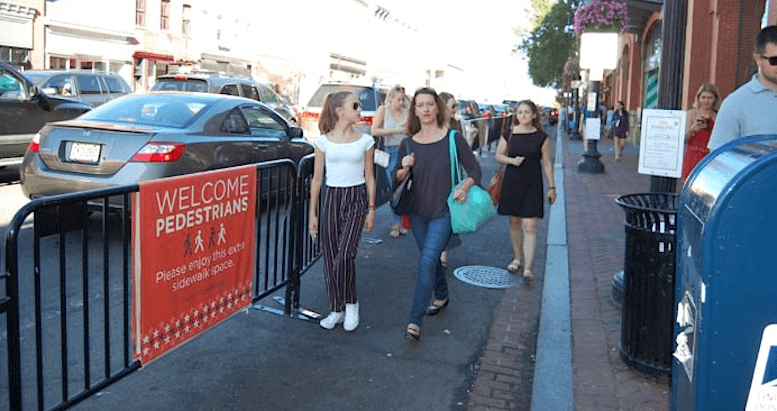Sidewalk Widening Plans, Concerns in Georgetown
By • July 13, 2020 0 1014

As Georgetowners cautiously leave their shelter-in-place abodes during the second of four phases of D.C.’s reopening, an inherent charm of the town has become a focal point for change: the narrow, crowded sidewalks.
How can Georgetown’s attractive brick sidewalks be widened to accommodate diners, lines of customers, sidewalk sales, curbside pickups and drop-offs, merchandise deliveries and trash storage and collection in front of businesses — as well as space for pedestrians — all while following the District’s coronavirus social distancing restrictions?
Even more of a Georgetown problem: how to maintain vital parking spaces that may be replaced by bike and scooter paths and corrals, parklets and street-side dining areas?
“Time is of an essence to decide what to do,” said Jamie Scott, the Georgetown Business Improvement District’s planning and economic development director, at the June 29 meeting of Advisory Neighborhood Commission 2E. “Not one size fits all. It will be more like a block-to-block approach impacting commercial side streets, M Street and Wisconsin Avenue up to probably Q Street. We are still in the planning process after numerous meetings, trying to find what changes each business needs and how to implement phased approaches for different options and different scales of change.”
“No one is talking about these being permanent changes,” ANC 2E Chairperson Rick Murphy emphasized. “But our ANC requests to be a full partner in the development of this pilot program to ensure it is meeting the community’s needs throughout its life.”
Some of those needs, identified in a June 29 resolution sent to the District Department of Transportation, include: increasing bike and scooter parking locations that will not impede vehicular traffic, prohibiting scooter and bike use on the sidewalks, negotiating with private parking lots (including those of temporarily closed banks) for low parking fees, addressing unnecessary sidewalk impediments such as unused newspaper boxes and ensuring that curb cuts and tree boxes serve those with different mobility needs.
“This all needs to be put on a fast track, especially for restaurants,” said Georgetown business owner and former Advisory Neighborhood Commissioner Ed Solomon. “Needs of local diners, especially on N, P and O Streets, who drive should come first. They depend on parking on Wisconsin Avenue and 31st Street.”
“We obviously want to be as supportive as we can for Georgetown business to survive and thrive,” said Bill Starrels, like Solomon a former advisory neighborhood commissioner. “One of my concerns is that the changes protect pedestrians from errant vehicles.” Starrels favors filling road barriers as full of water as possible and installing “Barnes Dance” signal timing at major intersections, so that all pedestrians cross at the same time, separated from all vehicles.
“Parking for commerce is essential,” Starrels added. “We don’t want to force Georgetown customers and staff to park in the residential streets.”
For now, however, parking meters and rush-hour parking restrictions in Georgetown are not being enforced, police officers told The Georgetowner on July 9.

